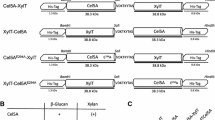Abstract
To engineer a multifunctional xylan-degrading enzyme, a chimera was created by fusing the xylanase domain of the Clostridium thermocellum xylanase (xynZ) and a dual functional arabinofuranosidase/xylosidase (DeAFc; from a compost starter mixture) through a flexible peptide linker. The xylanase domain of xynZ possesses previously unreported endoglucanase activity. The chimera, possessing the activities of xylanase, endoglucanase, arabinofuranosidase and xylosidase, was expressed in E. coli and purified. The chimera closely resembled the parental enzymes in pH, temperature optima and kinetics, and was more active than the parental enzyme mixture in the hydrolysis of natural xylans and corn stover.



Similar content being viewed by others
References
Adelsberger H, Hertel C, Glawischnig E et al (2004) Enzyme system of Clostridium stercorarium for hydrolysis of arabinoxylan: reconstitution of the in vivo system from recombinant enzymes. Microbiology 150:2257–2266
Anthon GE, Barrett DM (2002) Determination of reducing sugars with 3-methyl-2-benzothiazolinonehydrazone. Anal Biochem 305:287–289
Biely P, Mislovicova D, Toman R (1988) Remazol brilliant blue-xylan: a soluble chromogenic substrate for xylanases. Methods Enzymol 160:536–541
Blum DL, Kataeva IA, Li XL et al (2000) Feruloyl esterase activity of the Clostridium thermocellum cellulosome can be attributed to previously unknown domains of XynY and XynZ. J Bacteriol 182:1346–1351
Doi RH, Kosugi A (2004) Cellulosomes: plant-cell-wall-degrading enzyme complexes. Nat Rev Microbiol 2:541–551
Fan Z, Waschal K, Lee CC et al (2008) The construction and characterization of two xylan-degrading chimeric enzymes. Biotechnol Bioeng (in press). doi:10.1002/bit.22112
Flint HJ, Martin J, McPherson CA et al (1993) A bifunctional enzyme, with separate xylanase and β(1, 3-1, 4)-glucanase domains, encoded by the xynD gene of Ruminococcus flavefaciens. J Bacteriol 175:2943–2951
Gilbert HJ, Hazlewood GP, Laurie JI et al (1992) Homologous catalytic domains in a rumen fungal xylanase: evidence for gene duplication and prokaryotic origin. Mol Microbiol 6:2065–2072
Grepinet O, Chebrou MC, Beguin P (1988a) Nucleotide sequence and deletion analysis of the xylanase gene (xynZ) of Clostridium thermocellum. J Bacteriol 170:4582–4588
Grepinet O, Chebrou MC, Beguin P (1988b) Purification of Clostridium thermocellum xylanase Z expressed in Escherichia coli and identification of the corresponding product in the culture medium of C. thermocellum. J Bacteriol 170:4576–4581
Lorenz WW, Wiegel J (1997) Isolation, analysis, and expression of two genes from Thermoanaerobacterium sp. strain JW/SL YS485: a β-xylosidase and a novel acetyl xylan esterase with cephalosporin C deacetylase activity. J Bacteriol 179:5436–5441
Montross MD, Crofcheck CL (2004) Effect of stover fraction and storage method on glucose production during enzymatic hydrolysis. Bioresour Technol 92:269–274
Wagschal K, Franqui-Espiet D, Lee CC et al (2005) Enzyme-coupled assay for β-xylosidase hydrolysis of natural substrates. Appl Environ Microbiol 71:5318–5323
Wagschal K, Franqui-Espiet D, Lee CC et al (2007) Genetic and biochemical characterization of an α-L-arabinofuranosidase isolated from a compost starter mixture. Enzyme Microb Technol 40:747–753
Wagschal K, Heng C, Lee CC et al (2008) Biochemical characterization of a novel dual-function arabinofuranosidase/xylosidase isolated from a compost starter mixture. Appl Microbiol Biotechnol (in press). doi:10.1007/s00253-008-1662-4
Acknowledgements
We thank Drs. K. Wagschal and C. Lee of the U.S. Department of Agriculture for providing the DeAFc gene, technical support and helpful discussions. We also thank Dr. I. Maiti of the University of Kentucky for providing the Xyln gene and Dr. M. Montross for supplying the corn stover substrates. This work is supported by a grant from the U.S. Department of Agriculture to L.Y. (2006-35504-17413).
Author information
Authors and Affiliations
Corresponding author
Electronic supplementary material
Below is the link to the electronic supplementary material.
Rights and permissions
About this article
Cite this article
Fan, Z., Werkman, J.R. & Yuan, L. Engineering of a multifunctional hemicellulase. Biotechnol Lett 31, 751–757 (2009). https://doi.org/10.1007/s10529-009-9926-3
Received:
Revised:
Accepted:
Published:
Issue Date:
DOI: https://doi.org/10.1007/s10529-009-9926-3




